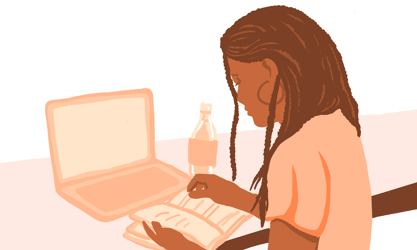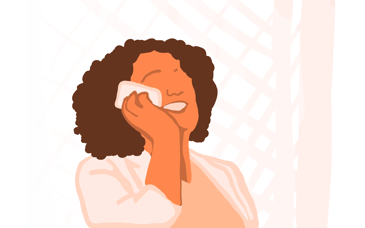This article is a part of The Human-Centered Work Project, a hub of research-based insights and resources on redesigning...
Redefining “Professionalism”

Posted by Brenna Traynor on Sep 15, 2020
This article is a part of The Human-Centered Work Project, a hub of research-based insights and resources on redesigning work. The following insights come from research illuminating ways that white supremacy culture may be expressed in the remote workplace to provide tools and guidelines to help allies move forward with impactful cultural workplace change.
Traditional models of professionalism are not conducive to creating inclusive work environments.
In our research we found that the conventional, unexamined standard of professionalism experienced at Fortune 1000 companies can lead to BIPOC employees feeling pressure to strongly manage the aspects of themselves they share at work, both in remote and in-person work environments, hindering the trust and openness required to do truly collaborative work.
‘I’m only about 30% of my authentic self at work.’ - Jade*
In the American corporate work environment, professionalism is often seen as buttoned-up and sterile, neat in appearance, polished and collected. When you ask someone to picture a CEO, more than likely, they imagine a white man in a suit and tie.
Professionalism | noun
pro·fes·sion·al·ism | \ prə-ˈfesh-nə-ˌli-zəm \
-
- the conduct, aims, or qualities that characterize or mark a profession or a professional person
- the competence or skill expected of a professional
Standards of professionalism were built by white men, for white men, and create a culture of perfection, conformity, and homogeneity. They create a space built for the progression of only one type of person. If you don’t fit the description, you are often passed over for raises, promotions, or recognition. These white standards of professionalism require anyone entering into corporate America to conform to these standards.
While we know how these standards are detrimental, we recognize we aren’t experts at breaking them down and rebuilding new, inclusive definitions just yet. Within AnswerLab, as a services organization, we not only have to consider what these characteristics mean for us internally, but also how they apply when we interact with our clients. As our team steps into our clients’ spaces, both physical and virtual, we must navigate their standards and impressions of us too, adding another level of tension for some team members.
“They say to bring your whole self to work. But what they really mean is to bring the part of yourself that is going to impact the business and make us as comfortable as possible.” - Cameron*
In our research, we found that the American vision of professionalism is causing BIPOC employees to feel dissatisfied and disconnected in the workplace, unable to bring their full authentic selves to work. Even if professionalism is an unconscious element in the workplace, these white corporate standards exist, and do not create inclusive spaces for all employees.
Redefining "Professionalism"
We spoke with 12 people about their experiences at work, surfacing a wide variety of stories related to professionalism and conformity in the workplace. Some concepts were more obvious, and some were much more nuanced. Based on conversations with participants, third-party research, and internal discussions at AnswerLab as our guiding forces, we are breaking down the definitions of conventional professionalism and outlining new qualities and ways to create a definition of “Inclusive Professionalism.”
Broaden organizational definitions of professional appearance

All Black women we spoke with brought up their hair as a problem area when it came to looking or being perceived as professional. One participant, Jade*, recalled an internship she had in Washington, D.C. — a very prestigious one which Hillary Clinton had also completed. She felt she had to change her hair to conform to the white culture of the internship. While in D.C., she found a local salon and the woman who did her hair did it for free and touched it up often, saying “You’re not going to make it in D.C. with a kink in your hair! This is your reality and I want you to have the best.”
For Jade*, wearing her hair naturally was most comfortable and easiest for her, but she’d been coached to straighten it in order to get ahead. For her first several months at her new job she did so until she felt she had proven herself. Another participant, Vanessa*, said she had been told that her LinkedIn profile picture with an afro was unprofessional.
California is the first state to legally ban discrimination against hair styles. The CROWN (Create a Respectful and Open Workplace for Natural Hair) Act prohibits discrimination at work and school based on hairstyle and hair texture by extending protection for both categories under the FEHA and California Education Code. Whether you’re a California based company or not, adopting a policy of openness towards all hairstyles and appearances forwards/advances the breakdown of discriminatory standards of professionalism.
Just as there was an unwritten norm of professionalism that called for small/straight hair regardless of what was natural, some also felt constrained by an unspoken norm that home offices must fit a narrowly defined aesthetic. Our homes are an extension of our bodies which are now accessible and highly visible to our colleagues.
Our BIPOC participants had to rethink how her home was decorated when transitioning from the office to working from home during the pandemic. Some participants said the way white coworkers asked about their home spaces subtly exoticized them, instead of talking about details of home decor as a point of connection, as they did with non BIPOC colleagues.
Another young Black woman, Vanessa*, experienced this when people asked about her African flag decorative fabric on her walls. She experienced these conversations as intrusive and distancing. She has since completely adjusted the decor of her home office and paid more attention to the angle of her camera during work calls in order to avoid these extra “little conversations.”
Companies need to normalize multicultural appearance, spaces, and beliefs instead of placing value on homogeneous white-culture standards of professionalism. Having BIPOC in leadership positions can also help demonstrate these values.
 |
Take action: |
- Start with removing dress codes and hair requirements to be supportive of multiculturalism
- Train managers and hiring teams about important legislation, such as the CROWN Act, and how unconscious biases present themselves in this way
- Make sure you’re including inclusive language and materials in your job descriptions, onboarding, and training training processes. How are you sending the right message from the start?
- Encourage employees to take it upon themselves to learn about their colleagues’ cultures instead of exoticizing them based on appearance and asking intrusive questions
Create space for a full range of expression and communication styles
We were saddened, but not surprised, to discover that the managers and colleagues of BIPOC participants had expressed discomfort or annoyance with the ways they communicated. Many participants we spoke to mentioned being unable to communicate freely at work, being called terms like “aggressive” when expressing anything passionately.
Vanessa* related an experience in which her manager told her she complained too much. She reflected on the experience carefully, and thought about the way others on her team communicated — and sometimes complained. She concluded that her communication style was part of her culture and the “things we do as Black people aren’t professional.” As a result of this experience, she resolved to “practice how I say something” and contributed less to meetings.
Her manager noticed her quietness and commented that he would like to hear from her more often; later, when she shared a passionate opinion, it was characterized as “spicy” which caused her to “feel dismissed and undervalued.” Vanessa’s* quandary is very real — a very confusing and difficult experience for her and millions of others like her.
Priya*, who works as a user experience researcher for a large financial company, shared that she “grew up in a culture—Indian”—where people are:
very direct. And we’re very blunt. If my white colleagues were to watch that, they would probably think that we were a little rude. And I’ve been accused of being too blunt. … I’ve gotten in so much trouble, so I’ve learned to just kind of censor myself. … My people are passionate people. And I see that as a cultural identity. … I don’t think that aspect of my character is welcome at work. So I must behave in the roles that were set forth by my white colleagues and my white leadership … where, you know, it’s very beating-around-bush, it’s very polite. … I have to code switch and that’s an indicator to me that I am operating in an environment that isn't welcoming of my experience as a person of color.
Priya* then offered an example of how differently she and a Black colleague of hers spoke about work projects than when she was talking about projects with white colleagues. Her Black colleague, she said,
can shoot it really straight with me and I won't get offended. But, I tell you, if she shot it straight with her white colleagues they would get offended and same with me [if I did that]. So I’ve learned to kind of be nice and “respectful.” That’s a loaded word, but yeah.
 |
Take action: |
- Initiate upward reviews so employees can give feedback about managers. Anonymous 360° reviews can achieve a similar effect, enabling employees to not only share feedback with their direct reports or managers, but also with their teammates
- Provide training on social and emotional literacy so individuals have more tools for exploring challenging feelings
- Train employees in facilitation skills that create space for the full range of emotions
- Create restorative practices so interpersonal conflicts are given space and attention to be resolved
Honor everyone’s spirituality and religious culture
Rather than seeing religious traditions, holidays, or customs as inconveniences or superficial conversation-starters, companies must acknowledge that these are important dimensions of employees’ lives — and design the workday and calendar with the flexibility required to honor them.
One South Asian man, Aarav*, felt his culture was not welcome in his workspace, particularly around religion. As a Muslim, he prays five times a day and often had to skip prayer sessions in order to meet deadlines. While his company recognized many Christian holidays as company holidays, Islamic holidays weren’t even known about or acknowledged by his coworkers. While it’s considered unprofessional to bring religion into the workplace, it’s also normal for Christian customs, holidays, and imagery to be seen in American offices.
Although there are federal laws banning discrimination based on religion, there’s nothing requiring companies to embrace non-Christian religions and this leads to exclusion, added scheduling burden, and stress for non-Christian employees. To create a greater sense of belonging, companies should recognize other religions and help all of their employees understand and learn about different holidays and customs. Showing employees they acknowledge and celebrate all religions and cultures will help move the needle away from bigotry against non-Christian beliefs, and helps create an open space for religious minorities to feel more comfortable being themselves at work.
 |
Take action: |
- Make all religious holidays available on a company-managed shared calendar to increase awareness and understanding. Encourage employees to check this calendar prior to scheduling company or external events.
- Re-examine your designated Company Holidays to provide “flex days” for employees to take typically unrecognized holidays more easily.
- Host organized employee events celebrating non-Christian holidays for team members to share customs, food, and cultural traditions with their fellow colleagues, while ensuring employees have agency around the event design, timing, and their involvement
See employees’ compassion and caregiving as sources of strength
Being loving and building connection is seldom seen as a dimension of professionalism; coolness is rather the norm. One of the characteristics of white supremacy culture as expressed in Okun’s framework is “individualism,” and we saw how this conventional professional norm came into tension with the more collectivist, familial, networked approach we found that BIPOC individuals intentionally cultivated.
“You know,” Priya* shared, “for people of color cultures, their cultural ideas are built around this collectivist mindset. We're all here to help each other out. You know, we move as one.”
BIPOC individuals we spoke with were deeply involved in complex caregiving work that inspired and challenged them, enabled them to express leadership skills, and required energy and attention. Parenting, community work, caring for extended family, close friends, and others who suffer from exclusion are examples. And, because of the racism they experience, there were times when taking time for self-care was critical for them.
Jade* experienced coldness often from workers who did not make space for many forms of caregiving natural to her: who made it difficult for her to attend a funeral of a member of her created family or even take a few hours off to take care of herself after an unfortunate experience with a neighbor that left her feeling extremely vulnerable.

We heard about how the relationship-building work our BIPOC participants naturally and effortlessly did was often undervalued and unnoticed in a corporate culture that focused only on what could be seen and measured — or dismissed if it couldn’t be owned and driven by white leadership.
Galvanized by the challenges her community was facing, Jade* took initiative to create a series of events to help the Black community impacted by the pandemic. It was something her company could have supported and amplified; it showed a level of profound leadership and compassion.
Unfortunately, Jade* had the experience that her colleagues instead sabotaged her effort by assigning her invented and unnecessary work exactly during the time period of her event. And, she pointed out that after learning about her event online, company executives launched their own event with an identical scope without engaging with her.
Supporting employee caregivers is a critical dimension of inclusive, human-centered work and something we’ve been learning a great deal about. It requires different ways of thinking about time and work, and new kinds of support and benefits, the topic of future articles.
 |
Take action: |
- Learn about the communities your employees deeply care about. Create leadership opportunities for them to identify ways your company could be serving them, and give them the time and resources to carry great work out.
- Acknowledge that for many cultures, one’s immediate family is only a tiny part of a much larger, and very important, relational network. Make space for employees to live their caregiver roles in culturally appropriate ways.
As we all work towards building more inclusive work environments, we need a new understanding of what it means to be “professional.” Join us in embracing naturalness, cultural and religious customs, lovingness and the ability to build connection, and a range of communication styles as not just nice-to-haves, but important dimensions of modern, inclusive professionalism. This way, companies can create a beautiful microcosm of a truly multicultural world in which all can thrive.
*All participant names have been changed to ensure anonymity and privacy.
Learn more about the origins of The Human-Centered Work Project and sign up to be the first to receive the latest findings and resources.
Brenna Traynor
Brenna Traynor (they/she), a member of our AnswerLab Alumni, was a Principal UX Researcher at AnswerLab with nearly 10 years of experience leading foundational, qualitative, and mixed-method research studies. Their main passion is understanding unique experiences, particularly with historically marginalized groups such as LGBTQIA+ and BIPOC communities. Brenna is the founder and chairperson of RainbowLab, AnswerLab's employee-led resource group for LGBTQIA+ AnswerLabbers. They hold a degree in Anthropology with a minor in Linguistics from California State University, Long Beach.related insights
Get the insights newsletter
Unlock business growth with insights from our monthly newsletter. Join an exclusive community of UX, CX, and Product leaders who leverage actionable resources to create impactful brand experiences.